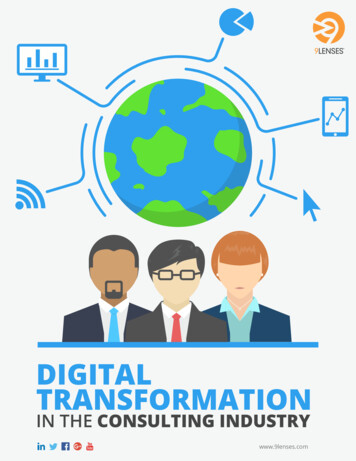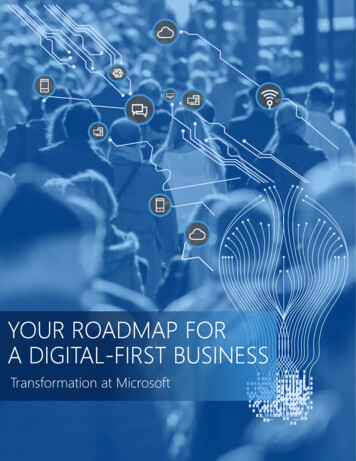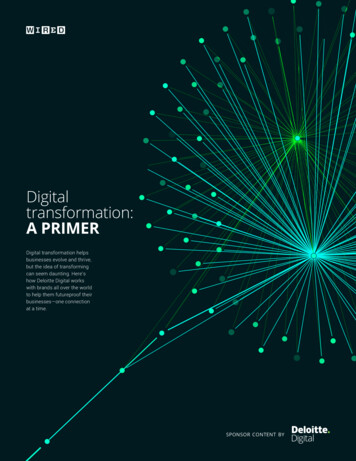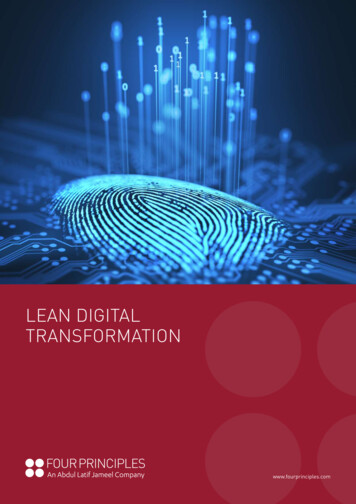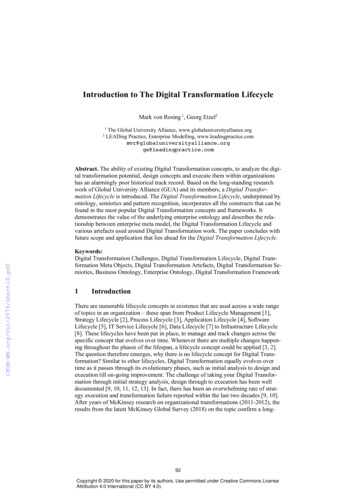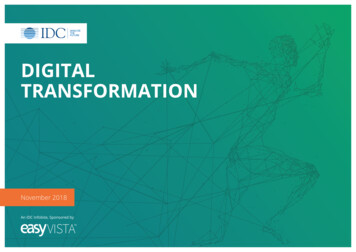
Transcription
DIGITALTRANSFORMATIONNovember 2018An IDC Infobite, Sponsored by
Transforming IT is a MUST to Meet BusinessExpectations and Digital Transformation OutcomesIDC PREDICTSTHAT BY 202060%of CIOs will implement an IT business model and a digital-first culture that focuseson creating digital products and services that improve user and employeesatisfaction. Business-oriented IT will take center stage in DX JourneysGiven that IT is a launchpad for digitaltransformation and business innovation,how do you view the current state of yourIT today? Is it a cost center or a businessenabler?Our 2018 IT Service Management (ITSM)End-User Study finds that less than 6%of organizations have core IT embeddedin digital innovation. These leading-edgeenterprises across multiple verticals areyielding benefits because their IT andapplications management is smooth,modern, optimized, and automated. Thisin turn is improving their speed to market.These organizations are at the highestlevel of DX maturity — Stage 5, or“Digital Disrupter” — revealing the closeties between IT transformation and digitaltransformation.Digital transformation is primarily aboutimproving customer experience and makingthe company agile to respond to changingmarket dynamics quickly. This is possible ifthree enterprise dimensions are optimizedusing next-generation technologies andmethodologies: people, risks, and processes.The ultimate goal is toenable digital, business,and IT teams to operate ina unified, frictionless wayfor true, enterprisewidedigital transformationIDC sees modern IT and ITSM strategiesas important to address all three areasof consideration and overcome the DXchallenges. Our ITSM research shows that onekey requirement for accelerating DX initiativesis aligning IT and the business.Feeling the heat of competition from businesses that deliver business-aligned IT, three-quarters admit that their IT needs to get closer to the business and “develop skillsin business strategy.” In fact, integration of IT with business is the most desired skill needed for DX success, the study revealed. An overwhelming majority (81%) said thatachieving business agility is the top driver that will shape IT strategy by 2020.Aligning IT Strategies with Business Expectations for Digital Transformation ITSM Digital Transformation EasyVistawww.easyvista.com/dxDownload this complimentary IDC research study to learn how to improve business agility, employee experience and process automation for successful digital transformation. IDC Oct 2018. All rights reserved.IDC Infobite Sponsored by
How Ready is Enterprise IT to Respond toDigital Business Imperatives?IDC’s survey of 300 enterprises in May 2018(source: IDC s 2018 IT services Survey, N 300) revealsthat there are clear gaps between IT and the business,leaving a lot to be desired. For 35% of organizations,this gap between IT and the business is a key obstaclein running digital innovation projects.The top 4 considerations to execute digitaltransformation and business innovation are:Governance, risk, andcompliance managementKnowledge managementand sharingAgile delivery ofapplications and servicesSkills and talentmanagement (people)This means that transforming ITSM is a key aspect of the technologydimension in the DX journey. Delivering business-oriented IT services canturn IT departments from the “most complained about” to a shining star.As a result, more than three-quarters (77%) of organizations want to makeITSM processes more agile to support business needs.The studyhighlights how ITtransformation is tied to key businessoutcomes aligned to DX objectives:MODERNIZING ITSM TOOLS. 83% of businesses said modernizingtheir ITSM tool with a more agile solution was an overwhelming priority.ITSM agility improves IT’s value to the business through faster problem resolutionand reduced service desk calls, and in turn improve developer and employeeproductivity and speed of innovation.83%LICENSE MANAGEMENT. As IT becomes more fragmented and complex, licenseand contractual agreements are becoming a management headache. Gaining deepervisibility through ITSM and better ability to manage full asset lifecycle and asset trackingis becoming fundamental for 68% of businesses, making “frictionless” IT services strategicand critical to business process improvement and risk management.68%UNIFIED ITSM STRATEGY. Having a unified and consistent ITSM strategy to makemeaningful comparisons between environments or applications was also important tomore than 60% of organizations.60%EMPLOYEE EXPERIENCE. What also stood out was the emphasis on simplicityand easier user experience. Improving self-service adoption to resolvebusiness issues faster was important for over half (53%) of largeorganizations.Aligning IT Strategies with Business Expectations for Digital Transformation ITSM Digital Transformation EasyVistawww.easyvista.com/dxDownload this complimentary IDC research study to learn how to improve business agility, employee experience and process automation for successful digital transformation. IDC Oct 2018. All rights reserved.IDC Infobite Sponsored by53%
Q. What new skills should IT leadership have to be effective in yourorganization’s digital or new business initiatives?90%80%77%70%In IT, the ITSM environmentis also seen as lagging72%71%55%60%50%51%For nearly 50% ofenterprises respondingto the survey, thecomplexity of servicedesk ticket handlingis seen as costly andinefficient, and leads tolow productivity.Within IT, existing ITSM architectureis severely lacking in:40%30%20%Agility. For 7 out of 10 organizations, it is notagile enough to deliver IT to business faster.10%0%BusinessstrategyAn intimateunderstanding ofour core businessprocessesThe ability to find toolsand technologies toimprove knowledgesharing and collaborationamong business unitsEffectivecommunicationat the seniorleadership levelThe ability to link theusage of new technologiessuch as cloud, Big Dataanalytics, mobility, or IoTinto business outcomesVisibility. 6 out of 10 don’t have the granularvisibility to detect IT service issues and fix themquickly.More than 50% of organizations alsostruggle with: The ITSM study reveals that existing legacy IT environments,processes, and ITSM strategies are hampering DX progress. For 80% of businesses, infrastructure, IT management complexities,and meeting security needs are hurdles to executing on DX. For nearly half of organizations, ITSM limitations such as a lackof tools to remediate IT problems quickly and to provide effectivesupport of technology for users were primary obstacles.Aligning IT Strategies with Business Expectations for Digital Transformation ITSM Digital Transformation EasyVistawww.easyvista.com/dxDownload this complimentary IDC research study to learn how to improve business agility, employee experience and process automation for successful digital transformation.Best practices. Adapting best practices such asITIL or DevOps because of ITSM limitations.Self-service. Having high volumes of servicedesk tickets with no self-service in place.Quality. Cannot meet performance, availability,and service quality expected by business users. IDC Oct 2018. All rights reserved.IDC Infobite Sponsored by
Transform ITSM to Empower Businessesto Drive Digital TransformationAcknowledging the need to align IT and business teamstogether is a critical first step, but the journey doesn’tend there.Investment and modernization efforts should bedirected to the most severe IT pain points to benefitfrom transformation.The emphasis is clearly onspeed of business,costs, risk, andcustomer satisfaction.Want to know what your peers are doing?The top 10 ITSM priorities revealed in the study give a glimpseinto how ambitious businesses want to leverage innovation inmodern ITSM tools and transform service management.This clearly aligns with the3 areas of consideration —risk, people, process.Make ITSM processes more agileModernising ITSM to make it DevOps-ReadyImprove business process automation, orchestration, and managementLeverage automation to streamline IT services deliveryReduce ITSM costs and complexitiesImprove IT and financial management to optimize use of technology assetsImplement best practices for governance, security, and compliance, such as ITILImprove user experience to boost productivity and support innovation – 65% insisted on this!Improve IT services delivery and meet business expectations of ITInvest in self-service technologies to make ITSM user-friendlyAligning IT Strategies with Business Expectations for Digital Transformation ITSM Digital Transformation EasyVistawww.easyvista.com/dxDownload this complimentary IDC research study to learn how to improve business agility, employee experience and process automation for successful digital transformation. IDC Oct 2018. All rights reserved.IDC Infobite Sponsored by
Those organizations actively transforming theirITSM and IT architectures are looking for:Ease of use and modern features andfunctionalities — such as drag-anddrop configuration, high scalability, orlow-code customization — stood out asthe top criteria for investment74%The ability to provide access to ITSMthrough role-based apps, portals,and dashboards to improve the userexperience were the second set ofcriteria on the wish list, with thistopping the list for large enterprise68%Aligning IT Strategies with Business Expectations for Digital Transformation ITSM Digital Transformation EasyVistawww.easyvista.com/dxDownload this complimentary IDC research study to learn how to improve business agility, employee experience and process automation for successful digital transformation.Advanced self-help, mobility,automation and self-service capabilitiesthat deliver knowledge in an effectiveway were also important61% IDC Oct 2018. All rights reserved.IDC Infobite Sponsored by
Checklist for IT and ITSM Modernization to Turn it Intoa Business and Digital Transformation EnablerDigital Transformation is not an option —it is an imperative to stay relevant2Transforming process and technologies:ITSM modernizers are also looking for solutions that can help with:IT transformation is at the heart of DX, with 88% of organizations seeingIT as “very important” or “important” to successfully execute on digitalinnovation. Within this, transforming ITSM is a key aspect. The digital erais forcing enterprises to rethink their technology, people, process, and riskstrategies, as well as the KPIs to measure them.Better visibility into financial and serviceutilization data such as license compliance, assetdepreciation, and budget allocationIDC’s 2018 IT Service Management (ITSM) End-UserStudy shows that empowering employees with highlysatisfying IT services is a differentiator for competitiveadvantage.Automation with powerful business rules tostreamline complex processes — getting thefundamentals of ITSM automated and runningsmoothly to free up time for innovative projectsThe ability to separate data and security tosupport geographic or departmental needs in oneinstanceProgress in all the key ITSM areas of risk, people, and process must bealigned to tackle the deeply entrenched legacy culture, IT, and process issues.1Transforming the user experience:Determined organizations are seeking to leverage innovationfrom ITSM vendors to meet IT users’ needs and provide themwith a fast, simple, and satisfying IT services experience toboost productivity, collaboration, and talent retention. Astechnology innovation and digital transformation becomecommonplace, there is a skill and talent war emerging inwhich organizations are striving to attract the best talent toarchitect their digital business plans.To download the full IDC InfoBrief, Aligning IT Strategies With BusinessExpectations for Digital Transformation, go to: http://www.easyvista.com/dxAnalytics and reporting capabilities to visualizeservice delivery trends and deliver robust SLAs3Transforming cost and risk issues associated with legacy:ITSM enterprises are looking to reduce costs and ITSM complexitythrough low total cost of ownership with flexible licensing anddeployment models (SaaS, on-premise, on-premise subscription). IDC Oct 2018. All rights reserved.IDC Infobite Sponsored by
The top 4 considerations to execute digital transformation and business innovation are: Governance, risk, and compliance management . MODERNIZING ITSM TOOLS. 83% of businesses said modernizing their ITSM tool with a more agile solution was an overwhelming priority. ITSM agility improves IT's value to the business through faster problem .




